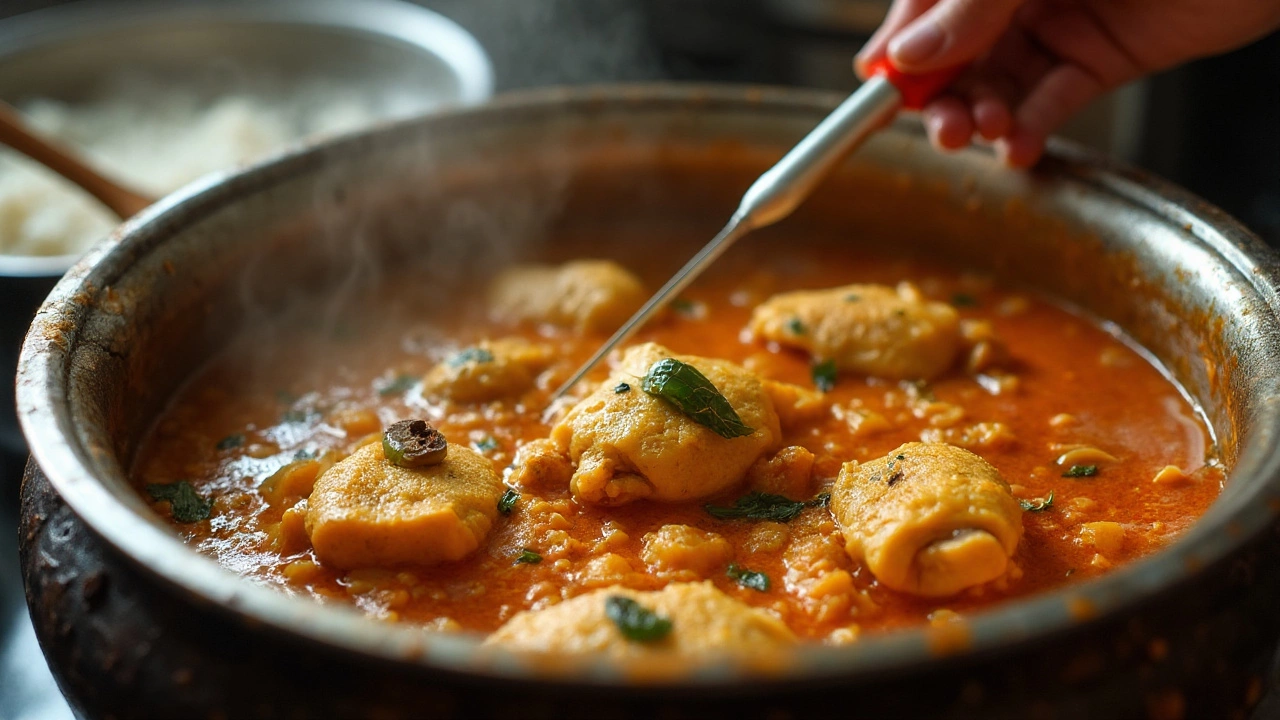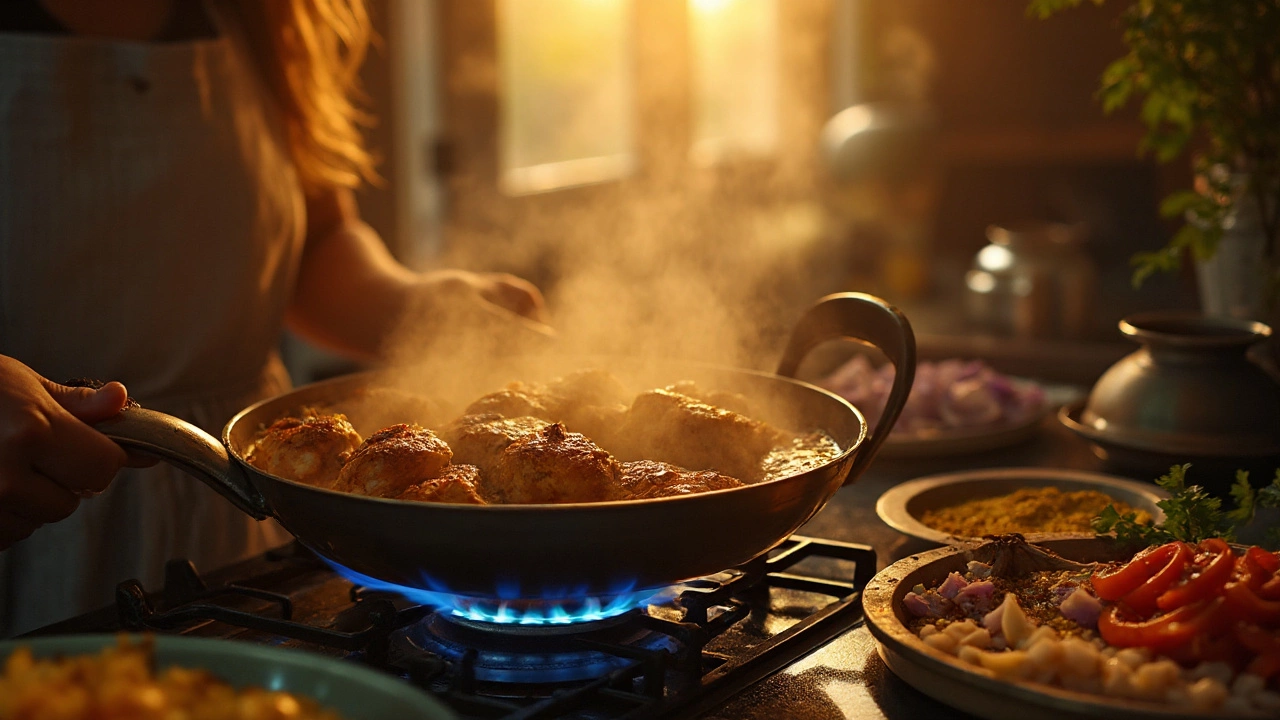You want juicy chicken and a full-flavoured sauce, not dry chunks floating in something bland. The question is simple-do you cook the chicken first, or let it finish in the curry? The short answer: both approaches are right, depending on your cut, your curry style, and how much time you’ve got. I’ll walk you through what actually matters-texture, browning, timing, and food safety-so you can lock in tender meat and a sauce that sings.
By the end, you’ll know exactly when to drop raw chicken into the masala, when to sear or grill first, and how to hit safe temperature without overshooting into rubbery territory. I cook a lot of chicken curry at home here in windy Wellington, and the fix for most problems is usually technique, not some magic ingredient.
- TL;DR: You do not have to pre-cook chicken for curry. Many classic Indian curries simmer raw, marinated chicken directly in the sauce. Pre-cooking (searing, grilling, roasting) adds charred flavour and firmer texture-perfect for dishes like tikka masala.
- Use thighs for forgiving, juicy results; breasts need gentler heat and tighter timing.
- Safe internal temperature for chicken is 74°C (165°F) per USDA FSIS and New Zealand’s MPI-hit it, then stop. Don’t keep boiling “to be sure.”
- Marinade matters: salt, yoghurt, acid (lemon), and spices help tenderness and flavour. A quick 30 minutes beats none; 4-12 hours is ideal for thighs.
- Different curry styles prefer different methods: North Indian butter chicken often uses pre-cooked/grilled pieces; many homestyle curries cook raw chicken in the masala; Thai curries simmer raw slices directly in coconut milk.
TL;DR: The quick answer
- If you want the softest, juiciest chicken with sauce that tastes deeply integrated: add raw, marinated chicken to the cooked masala and simmer gently until done.
- If you want smoky, grilled notes and clean, bouncy pieces that won’t shred: pre-cook (pan-sear, grill, roast, or air-fry) marinated chicken, then fold into the finished sauce.
- If you only have chicken breast and fear dryness: quickly sear for colour, finish gently in the sauce, and pull it as soon as it hits 74°C (165°F).
- Cooking for meal prep: pre-cook to 68-70°C (155-158°F), chill fast, then reheat in sauce to 74°C (165°F) on serving day to avoid double-drying.
- Food safety: Aim for 74°C (165°F) in the thickest part, verified with a probe thermometer. That’s the standard from USDA FSIS; New Zealand’s MPI aligns with it for poultry.
Here’s the plain truth: whether you cook chicken before curry depends on what you value most-velvety sauce integration versus charred, standalone pieces. There’s no single “correct” way, just trade-offs you can choose on purpose.
How to handle chicken for curry: three proven methods
Below are three reliable paths. Pick the one that matches your curry style, cut of chicken, and time window.
Method A: Simmer raw chicken directly in the sauce (classic, saucy, tender)
Best for: homestyle Indian curries (onion-tomato masala), Malay/Thai coconut curries, South Indian pepper/spice-forward curries, and anything where you want the meat to season the sauce from the inside out.
- Prep and marinate (15-60 minutes; longer if you can):
- Cut boneless thighs into 3-4 cm chunks. For bone-in pieces, keep them as-is.
- Season with 1% salt by weight (about 1 tsp fine salt per 500 g chicken). Add 2-4 tbsp yoghurt, a squeeze of lemon or 1 tsp vinegar, 1-2 tsp ginger-garlic paste, and your ground spices.
- Rest in the fridge. Even 30 minutes helps; 4-12 hours for thighs is ideal for tenderness and flavour.
- Build the base:
- Sweat onions in oil until deep golden; add ginger-garlic, cook until the sharp smell subsides.
- Add spices (garam masala, coriander, cumin, chilli, turmeric). Bloom briefly to wake them up-20-30 seconds.
- Add tomato (fresh or passata), then bhunao (cook down) until the oil separates and the raw tomato edge is gone.
- Add chicken and simmer gently:
- Scrape in the marinated chicken with its juices; stir to coat.
- Add just enough water or stock to barely cover. Bring to a light simmer-no hard boil.
- Cook until the thickest piece hits 74°C (165°F): 12-18 minutes for boneless thighs; 20-30 for bone-in; 6-10 for thin breast strips.
- Finish and rest:
- Adjust salt and acid (a squeeze of lemon) at the end.
- Off the heat, swirl in cream or coconut milk if using. Rest 5 minutes for juices to settle.
Why this works: As the chicken cooks in the sauce, its juices season the curry. Thighs stay plush even if you overshoot slightly. Breasts can work if sliced thin and cooked gently.
Method B: Sear or grill first, then finish in sauce (smoky, defined pieces)
Best for: tikka masala, butter chicken, kadhai chicken, or curries where charred edges add depth and the meat is meant to be distinct from the sauce.
- Marinate boldly:
- For tandoori vibes: yoghurt, lemon, ginger-garlic, Kashmiri chilli, garam masala, ground coriander, cumin, fenugreek (kasuri methi), salt.
- Thighs or breast both work; thighs are safer. Pat the chicken dry just before searing to avoid steaming.
- High-heat cook for colour and partial doneness:
- Cast-iron pan: oil, high heat, 2-4 minutes per side to brown. Don’t fully cook through-aim for 65-70°C (149-158°F).
- Oven/grill/air fryer: 220-240°C (425-465°F) until browned edges appear and internal temp is near 68-70°C (155-158°F).
- Build the sauce separately:
- For butter chicken: butter, aromatics, spices, tomato passata, a touch of sugar/honey to balance acidity; blend smooth; finish with cream and kasuri methi.
- For kadhai chicken: onions, peppers, crushed coriander and cumin, tomatoes-chunkier and fresher.
- Combine at the end:
- Fold the browned chicken into the hot sauce and gently simmer 3-5 minutes to reach 74°C (165°F). Don’t keep cooking after it hits temp.
Why this works: Browning (Maillard reactions) builds hundreds of savoury compounds. You get smoky, caramelised edges that won’t wash out in a rich sauce. Harold McGee writes extensively about this in “On Food and Cooking.”
Method C: Poach, sous vide, or use leftover roast (clean, precise, meal-prep friendly)
Best for: super-tender texture control, lean chicken breast, or when you need to stage cooking ahead.
- Poach gently:
- Bring a pot of well-seasoned stock or salted water to a bare simmer (80-85°C / 175-185°F).
- Add chicken pieces; hold below a boil until 72°C (162°F), then rest off heat to carry over to 74°C (165°F).
- Slice and add to sauce to warm through.
- Sous vide (advanced but foolproof for breast):
- Bag with salt and aromatics; cook 60-65°C (140-149°F) for 1-2 hours (follow a reputable guide), then sear briefly and finish in sauce.
- Leftover roast/rotisserie:
- Shred or cube; add near the end of cooking and simmer 3-5 minutes to heat through, preserving moisture.
Why this works: You separate doneness from sauce reduction. It’s tidy for big batches and avoids the panic of overcooking while you chase the perfect consistency.

Decision rules, time/temperature table, and a cook’s checklist
Here’s a fast way to choose your method.
Quick decision rules
- Using boneless thighs and want maximum saucy depth? Cook raw in the curry (Method A).
- Craving tandoori-style char or making butter chicken/tikka masala? Sear or grill first (Method B).
- Only chicken breast on hand? Either thin-slice and poach gently in the sauce, or pre-sear lightly then finish carefully (A or B with tight timing).
- Bone-in pieces? Simmer in sauce longer; flavour payoff is huge (Method A).
- Meal prep or big party? Pre-cook to near-done, chill fast, and reheat in sauce (Method C/B hybrid).
Typical times and temperatures
| Cut | Recommended method | Approx cook time in sauce | Target internal temp | Notes |
|---|---|---|---|---|
| Boneless thigh (3-4 cm pieces) | Raw simmer (A) or Sear+finish (B) | 12-18 min (A); 3-5 min to finish (B) | 74°C / 165°F | Very forgiving; ideal for weeknights |
| Bone-in thigh/leg | Raw simmer (A) | 20-30 min, sometimes 35 | 74°C / 165°F (avoid bone) | Big flavour; simmer gently |
| Chicken breast (chunks) | Light sear + finish (B) or gentle poach (C) | 6-10 min finish in sauce | 74°C / 165°F | Easy to overcook; probe helps |
| Chicken breast (thin slices) | Direct into hot sauce (A/C) | 3-6 min | 74°C / 165°F | Keep heat low; pull as soon as it hits temp |
| Grilled/tandoori pre-cooked | Finish in sauce (B) | 3-5 min to reheat | 74°C / 165°F | Don’t boil or it tightens |
The cook’s checklist (pin this)
- Salt right: about 1% salt by weight in the marinade (roughly 1 tsp fine salt per 500 g chicken) gets you seasoned to the core.
- Yoghurt is your friend: its lactic acid and calcium help tenderise. Great for thighs and tandoori/tikka profiles.
- Pat dry before searing: moisture kills browning. Marinated? Blot gently, then oil the pan, not the chicken.
- Bloom spices in fat: give dry spices 20-40 seconds in hot oil after onions/garlic to unlock aroma.
- Simmer, don’t boil: rolling boil squeezes moisture out of proteins; a gentle burble keeps them juicy.
- Thermometer > guesswork: pull at 74°C (165°F). Probe the thickest piece; avoid touching bone.
- Rest 5 minutes off heat: juices redistribute, and dairy finishes smoother.
- Balance at the end: a splash of cream or coconut milk softens heat; a squeeze of lemon sharpens dullness; a knob of butter rounds edges.
- Don’t crowd the pan when searing: work in batches for even browning.
- For dairy-based sauces: temper yoghurt/cream by stirring in off heat to prevent splitting.
Examples by curry style
- North Indian butter chicken: grill or sear marinated pieces first; fold into a buttery tomato-cream sauce.
- Homestyle onion-tomato chicken curry: raw, marinated thighs go straight into the bhunao’d masala; simmer until tender.
- Thai green curry: thinly sliced raw chicken poached directly in coconut milk and curry paste for a clean, fragrant finish.
- Chettinad chicken: bone-in pieces simmer in a robust, peppery masala-no pre-cook needed.
Mini‑FAQ and real‑world troubleshooting
FAQ
Do I need to pre-cook chicken for curry? No. Many traditional recipes add raw chicken into a fully cooked masala and simmer to doneness. Pre-cooking is optional and chosen for flavour/texture reasons.
What’s the safest internal temperature? 74°C (165°F) in the thickest part. That’s the safe minimum from USDA FSIS and is consistent with guidance from New Zealand’s Ministry for Primary Industries (MPI).
Which cut is best for curry? Boneless thighs. They’re juicy, forgiving, and flavourful. Breasts can work if sliced thin and cooked gently.
Can I add cooked rotisserie chicken to curry? Yes. Add it near the end, simmer 3-5 minutes to heat through. Don’t boil or it will toughen.
How do I avoid dry chicken breast? Thin slices, low simmer, and a thermometer. Pull the second it reaches 74°C (165°F). Marinate with yoghurt and salt for insurance.
Should I remove skin? Usually yes for saucy curries; skin turns flabby in liquid. Keep skin on for grilling or roasting, then remove or crisp separately.
Can I cook from frozen? Don’t drop frozen chicken straight into curry; it will dump water, cool the pot, and risk uneven cooking. Thaw safely in the fridge or use the microwave defrost, then cook.
My yoghurt curdled-what happened? Direct high heat or acidic tomato plus cold yoghurt can split. Temper by whisking warm sauce into the yoghurt, then stir back in off heat. Or add cream at the end.
Is brining better than marinating? For plain curries, a simple salt brine (1 tbsp salt per 1 L water, 30-60 minutes) hydrates and seasons. Yoghurt marinades both season and tenderise while carrying spices. Choose based on style and time.
What about bone-in versus boneless? Bone-in pieces take longer but give deeper flavour to the sauce. Boneless cooks faster and is easier to portion.
Troubleshooting by symptom
Chicken is tough and dry. Likely overcooked or boiled too hard. Switch to thighs, keep at a gentle simmer, and pull at 74°C (165°F). Marinate with salt and yoghurt next time.
Chicken tastes bland inside. Not enough salt time. Use 1% salt in the marinade and give it at least 30 minutes. Salt diffuses slowly; earlier is better.
Watery, thin sauce. You added too much liquid early or the chicken released water. Reduce the sauce before adding chicken, or simmer the sauce uncovered until thick, then add chicken to finish. If using breast, pre-cook partially and add later to avoid overcooking while reducing.
Oily split sauce. Either the tomato wasn’t cooked down before adding chicken, or dairy was boiled. Cook your masala until the oil separates, then add chicken. Finish dairy off heat.
Burning spices. Your pan was too hot or too dry. Add a splash of water to deglaze, scrape the fond, and keep moving. Bloom spices briefly, then add tomato/liquid.
Grey, steamed chicken when searing. The pan was crowded or the chicken was wet. Work in batches and blot the pieces dry. High heat, then don’t move them for a minute.
Unevenly cooked pieces. Inconsistent size. Cut chunks to similar size and stir a couple of times as they simmer. Probe the largest piece.
Meal prep and batch cooking tips
- Cook once, eat twice: Make a double batch of sauce; cook half with chicken now, freeze the extra sauce; add fresh chicken next time.
- Stage your chicken: Pre-cook to 68-70°C (155-158°F), chill quickly in shallow containers, then reheat in sauce to 74°C (165°F) when serving.
- Freezing: Curries with cream can split on thawing; reheat gently and whisk in a splash of fresh cream at the end.
- Label and date: Sauces freeze well for 2-3 months; cooked chicken for up to 2-3 months if chilled fast and sealed.
Practical examples you can copy tonight
Weeknight homestyle curry (serves 4, 35-40 minutes):
- Marinate 700 g boneless thigh with 7 g salt, 3 tbsp yoghurt, 1 tbsp ginger-garlic paste, 1 tsp turmeric, 2 tsp coriander, 1 tsp cumin, chilli to taste (15-30 min).
- Brown 2 sliced onions in 3 tbsp oil; add 1 tbsp ginger-garlic paste; bloom 2 tsp garam masala, 1 tsp paprika/chilli; add 400 g crushed tomatoes; cook until thick and glossy.
- Stir in chicken with any marinade; add 250-350 ml water to loosen; simmer gently 12-15 minutes to 74°C (165°F).
- Finish with lemon, a knob of butter, and coriander.
Butter chicken vibe (serves 4, 45 minutes active):
- Marinate chicken (as above, add 1 tsp kasuri methi, 1 tsp smoked paprika).
- Pan-sear or grill to 68-70°C (155-158°F), getting char.
- Make sauce: sauté 1 onion, add 2 cloves garlic and 1 tsp grated ginger; bloom 1 tsp garam masala, 1 tsp ground coriander, 1 tsp cumin; add 500 g passata; simmer; blend smooth with 2-3 tbsp butter and 100 ml cream.
- Fold chicken into sauce; simmer 3-5 minutes to 74°C (165°F); finish with crushed kasuri methi.
Thai-style green curry (serves 4, 25-30 minutes):
- Fry 2-3 tbsp green curry paste in coconut cream until aromatic and it splits.
- Add 400 ml coconut milk and 250 ml stock; bring to a gentle simmer.
- Add 500 g thin-sliced chicken breast; cook 3-6 minutes at a bare simmer until 74°C (165°F).
- Add veg (snow peas, capsicum), fish sauce, palm sugar, and basil at the end.
Once you understand the trade-offs, you’ll stop guessing and start choosing. That’s when your chicken curry gets reliably great-tender meat, big flavour, and zero stress.

